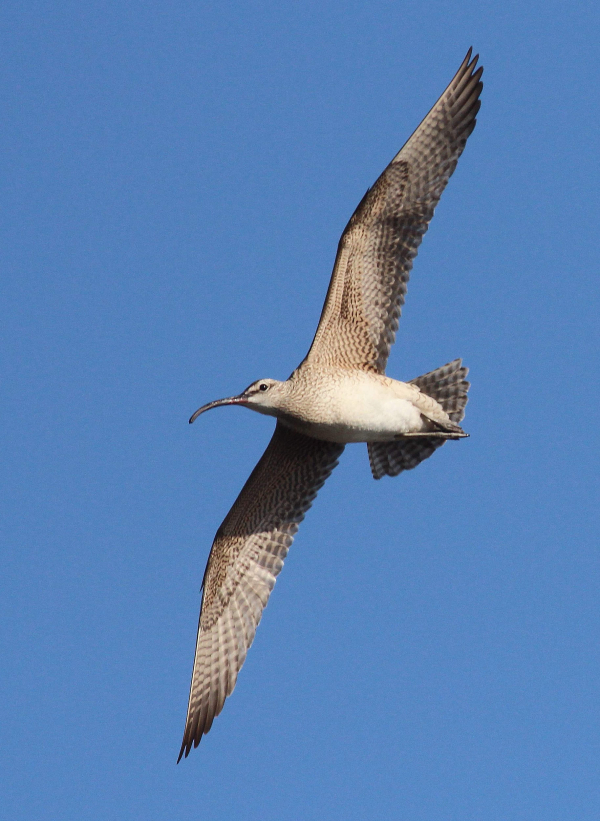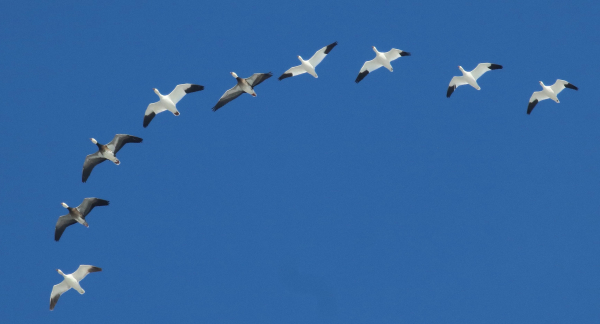
For long distance migrants such as this Whimbrel, which may have wintered along a coast in South America, the timing of their spring migration north to Arctic nesting areas is instinctive and the timing remains static regardless of weather conditions.

Snow and Ross’s Geese that winter along the Gulf Coast tend to begin migrating north as soon as weather conditions permit, stopping short of areas with ice and snow, then continuing northward as warmer weather produces open water and snow-free fields to feed in. Eventually, they make one last push into the Arctic to claim a territory at traditional colony nesting sites.
|
As North American birds begin their spring migrations northward from wintering areas, stopping at traditional resting and feeding areas for periods of time as they make their way to nesting ranges, our interest in bird migration is piqued. As we see the first migrants appearing and as we anticipate the waves of migrants that will soon follow, let’s examine some simple information about bird migration, especially spring migration, and what triggers birds to make these impressive and dangerous journeys from wintering areas to nesting sites.
Migrating birds can be divided into two groups: obligate migrants and facultative migrants, although these are not black and white divisions – many birds migrate using some aspects of both obligate and facultative migration strategies – but the two definitions are helpful in understanding what triggers a species’ migration.
For obligate migrants, the timing of travel is dictated by instinct. They begin migrating at about the same time each year, regardless of weather. An unusually warm or cool season won’t make them suddenly decide to change their departure dates.
Facultative migrants are more tuned in to the conditions of the moment. They have a standard time period for their migration, but they might alter the timing by days or weeks if the season is warmer than usual, or colder with snow cover later than usual. In short, they are more flexible.
During spring migration, when birds start migrating north from their winter range, obligate migrants migrate like clockwork. That includes certain songbirds, raptors, shorebirds, and others that migrate between the deep tropics to the far north. A Blackburnian Warbler that spends the winter in Peru, or a Wood Thrush wintering in Costa Rica don’t have any way to judge what the conditions like in the United States or Canada. Such species may wait for clear sky and favorable wind to launch each stage in their spring migration, and a major change in weather conditions won’t change their arrival dates significantly.
Meanwhile, most of the more flexible facultative migrants are birds that migrate shorter distances, with most of these wintering within the United States. These birds can sense local conditions and seize opportunities to move closer to their nesting areas when conditions permit. Overall weather patterns tend to apply to broad regions of the country, so if a given spring is warmer than usual, facultative migrants may gradually move north ahead of schedule. For example, if the weather is mild in late February, a Fox Sparrow in Tennessee might be triggered to fly a few hundred miles north into Ohio. Killdeers, Red-winged Blackbirds, American Woodcocks, Common Grackles, and even Tree Swallows are other species that may migrate to some areas farther north earlier than normal during a “early” spring.
Thinking of birds in this way makes it easier to predict their arrival. Will the warblers come back early this year? Yellow-rumped Warblers might, because they’re short-distance migrants, wintering mostly in the southern states. But Hooded Warblers won’t, because they’re obligate migrants that winter in the tropics of Central America.
Fall Migration Comparisons
It’s even easier to understand the differences between obligate and facultative migrants during fall migration. Among obligate migrants in North America, species such as Orchard Orioles and Yellow Warblers may start their southward migrations during August, when the weather is still pleasant and food is abundant. These birds aren’t driven south by cold weather or lack of food; they migrate south when innate instinct dictates.
By contrast, facultative migrants may linger until conditions – primarily weather changes and food availability – pushes them to migrate south. Ducks, geese, and swans need open water, and although some migrate early, others may stay in northern areas until wetlands freeze or food sources become covered by snow. The severity of the season may even influence how far south they migrate for the winter. Sandhill Cranes are another good example of facultative migrants, and in recent years, some Sandhill populations have been migrating later during fall and earlier in the spring due to weather conditions during a given spring or fall.
Adaptability
Can obligate migrants change their migration timing? Yes, but not in a single generation: A species can make such a shift over multiple generations. As with any other instinctive behavior, migration periods can and do evolve over time, and that adaptability is based on survival.
The perfect time for a bird to arrive at its nesting site is based on a balance of two pressures: It needs to arrive early to claim a prime territory. On the other hand, if it migrates north too far or too early, it might starve or even freeze. In every population of migratory birds, individuals vary somewhat in their migration timing. Birds that arrive at the perfect time are more likely to nest and raise young successfully, so their genes are more likely to be passed along to the next generation.
If the climate changes so that we experience warmer spring temperatures earlier, birds that arrive earlier may have an advantage. In that case early birds may get the best territories, and the healthiest mates, that raise more young than other birds in that population. Therefore, the genes that dictate an earlier migration are passed along to more of the offspring, and over a span of many generations the average timing of arrival of the entire population will gradually shift.
Ornithologists continue to study how different species can alter their migration timing. But with climate change already under way, some authorities are concerned that some migratory birds may not be able to adjust or evolve quick enough to keep in sync with the seasonal requisites of spring migration and the nesting season.
This article was based on an Audubon article that you can access at https://www.audubon.org/news/how-different-spring-migrants-decide-when-head-north
To refer to more information about the basics of bird migration, you can access another good discussion at https://www.allaboutbirds.org/news/the-basics-how-why-and-where-of-bird-migration/
Share your birding experiences and bird photographs at editorstbw2@gmail.com